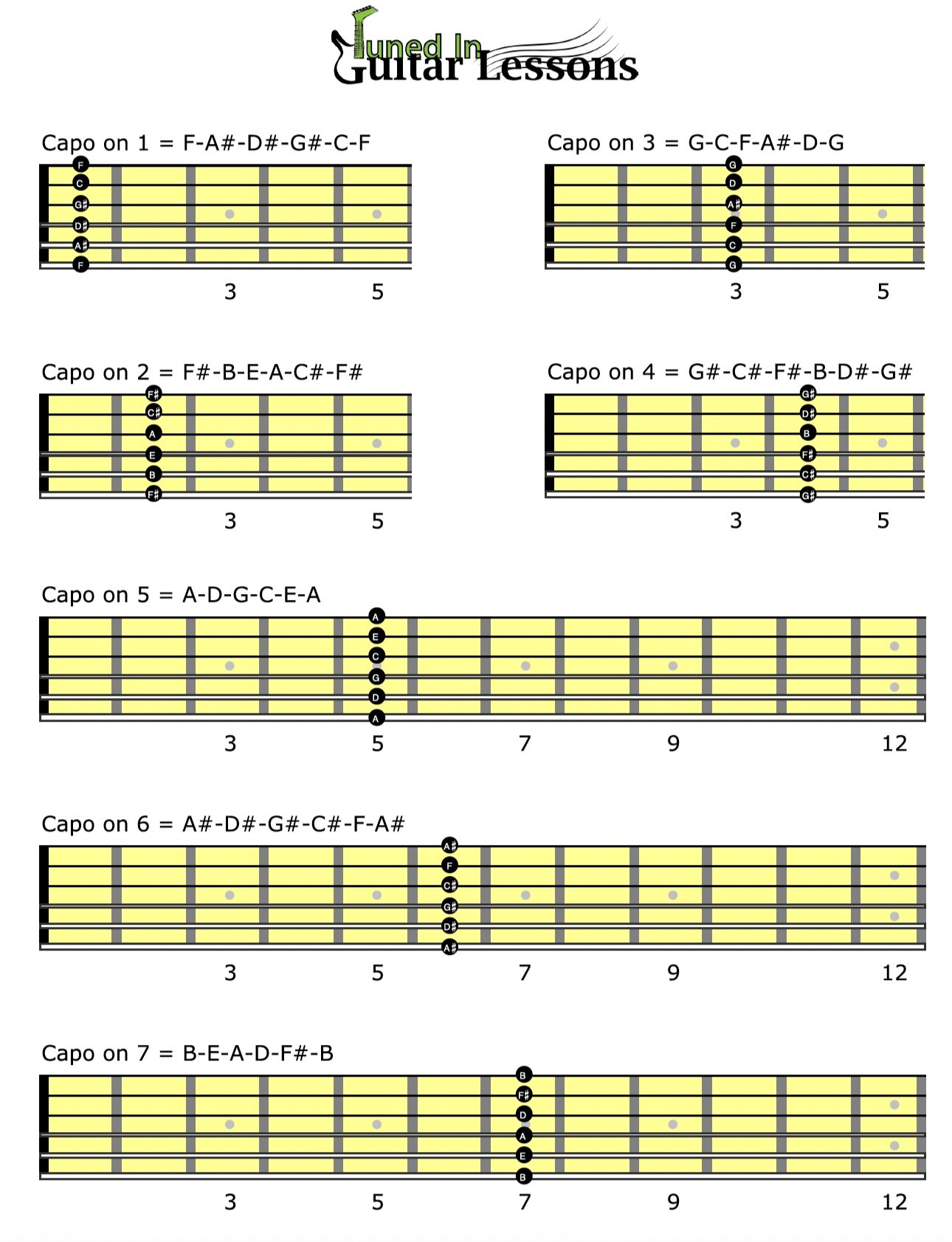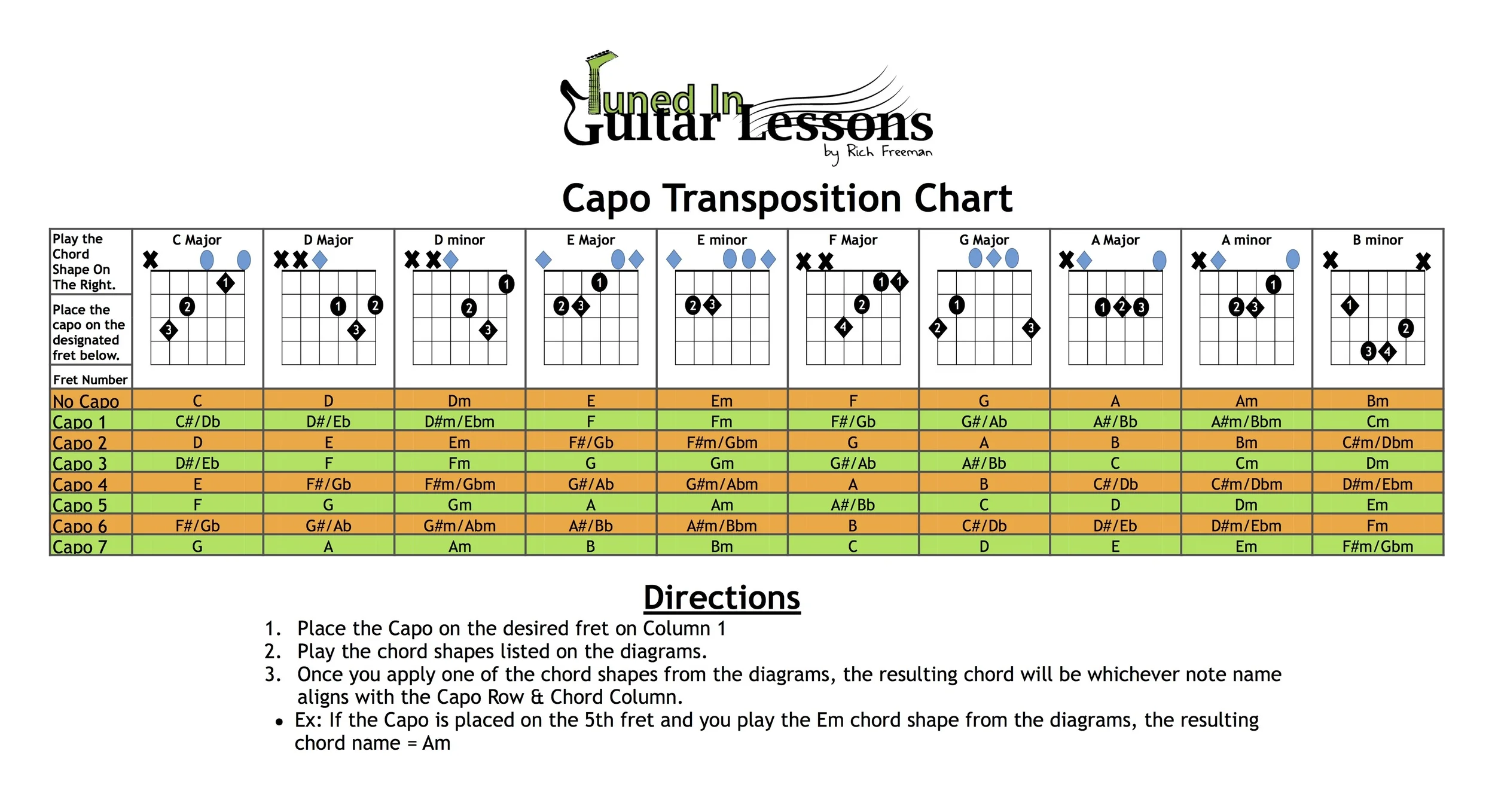Comprehensive Capo Transposition Chart
Capo Transposition Chart
When & How To Use A Capo
One of the coolest, yet most confusing devices created for the guitar is the Capo. I say this because many guitar players know what a capo is and why it's used (mainly for transposing), but they have no clue how or when to use it, and often don't know what the chords have been transposed to. These are all very important things to know! In this article, I will clarify "when" and "how" to use the Capo, as well as provide you with my Capo Transposition Chart which will help eliminate overthinking when trying to figure out what your new chord is called, and eliminate frustration that may accompany the "how" part of using a Capo.
Capo = A type of clamp fastened across all the strings of a fretted musical instrument to raise their tuning by a chosen amount.
There are also partial capos which don't cover all of the strings, this lesson is not intended for partial capos.
When To Use A Capo
Use a capo to find a new key that matches your singer's vocal range. If you want need a study guide to help you memorize notes on guitar and theory, don’t forget to check out my guitar flash cards, the “Fretboard Memorization Deck” on Amazon!
Use a capo to diversify the sound of your guitar.
Placing the capo very high on the frets can result in a "mandolin like" sound.
Use a capo when you have 2 guitar players who are playing the same chords.
In this scenario, one guitar player would play the chords in the open position, and the other guitar player would use the capo in a higher pitch range to compliment the open chords.
Capos are often used to bypass playing barre chords.
Some guitarists find it easier to sing and play open chords as opposed to barre chords. Because of this, they will often use the capo as a way to allow them to play chords not normally available in the regular open position.
Another reason to bypass playing barre chords with a capo is so that you can play extreme extensions of certain chords that otherwise would be impossible to play if you needed to hold onto a barre chord.
Don't just use a capo to avoid having to learn barre chords, this is a lame diversion. Capos are not superior to learning barre chords, and if you avoid learning your barre chords, you will seriously limit your ability to play all over the neck. Make sure you learn your barre chords 100%.
Before You Start Playing
Check your tuning! Many people don’t realize when they start using a capo that the tension from the capo pulls the strings a little sharp. This results in your guitar sounding out of tune. It’s important to tune the notes to the correct pitches.
Download & Print the Capo Tuning Reference Chart Here (Same as pictured below)
How To Use A Capo
Download & Print the Capo Transposition Chart Here (Same as pictured below)
Place the capo on any desired fret by clamping the capo in between the fret wires (NOT on the fret wires)
Here are 3 ways to use the Capo with the Capo Transposition Chart:
Capo Basics
Place the Capo on the desired fret on Column 1
Play the chord shapes listed on the diagrams.
Once you apply one of the chord shapes from the diagrams, the resulting chord will be whichever note name aligns with the Capo Row & Chord Column.
Ex: If the Capo is placed on the 5th fret and you play the Em chord shape from the diagrams, the resulting chord name = Am
Change the key
List all chords needed in the original song. For example we'll say we are playing a song that uses the following chords: Em G D A
To change the key, simply slide the capo to any fret you desire and apply the same chord shapes (Em G D A) and you have successfully changed the key of the song.
Stay in same key, but change the position of chords.
We'll use the same chords as the previous example: Em G D A
To stay in the same key, we need to now cross reference the transposition chart. The way you do this is to find a row in orange or green that contains the same four chords as your original key. In this case, rows 2, 5 & 7 all contain variations of chords Em G D A
Choose a position you'd like to test and find out if you like the resulting sound. We'll choose fret 2 for this example.
When you place the capo on fret 2 and play a Dm open chord shape, the notes you are playing translate to Em. So we would say the Dm shape = Em
With the Capo on the 2nd Fret, the four chord shapes you now play are going to be:
Shape Dm = Em
Shape F = G
Shape C = D
Shape G = A
Still have questions about this??? Fill out the form below with any questions.



